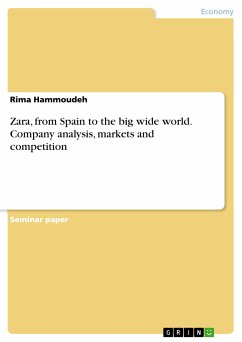Seminar paper from the year 2014 in the subject Business economics - Offline Marketing and Online Marketing, grade: 2,0, University of Applied Sciences Essen, language: English, abstract: Inditex is one of the largest fashion companies in the world and owns eight different store formats: ZARA, Pull & Bear, Massimo Dutti, Bershka, Stradivarius, Oysho, ZARA Home and Uterqüe - with over 6249 stores in 86 markets. This Assignment deals with ZARA, which is the most important and profitable subsidiary of Inditex. One main reason for ZARA¿s success is the company's right marketing strategy, which is based on defining and analyzing a certain target market. This assignment serves to define and to analyze ZARA¿s market from a global point of view. After a short introduction into the topic the company is presented in chapter 2 in-cluding the facts, figures, goals and objectives of ZARA. Chapter 3 concerns the external and the internal analysis of ZARA -using the theo-retical approaches PEST- and SWOT-Analysis. These analyzing techniques are necessary in order to obtain detailed information about the company, which is a prerequisite for the subsequent definition and analysis of the market presented in chapter 4. Chapter 4 deals with the market and the competitors. The analysis and definition of the market are based on facts and figures concerning the market segmentation, target customers, competitors and ZARA's strategy. The conclusion is presented in chapter 5, along with a personal, critical statement and the outlook on future studies.
Dieser Download kann aus rechtlichen Gründen nur mit Rechnungsadresse in A, B, BG, CY, CZ, D, DK, EW, E, FIN, F, GR, HR, H, IRL, I, LT, L, LR, M, NL, PL, P, R, S, SLO, SK ausgeliefert werden.









